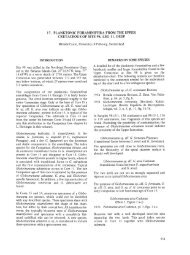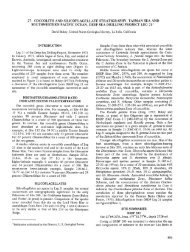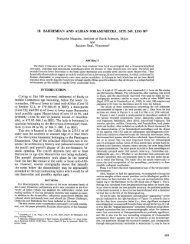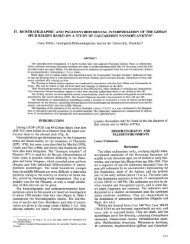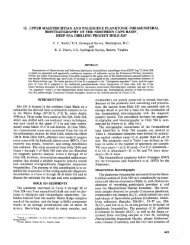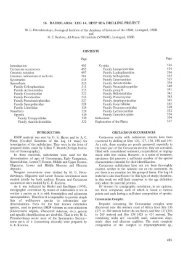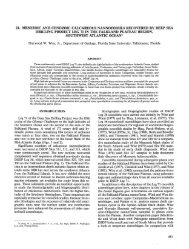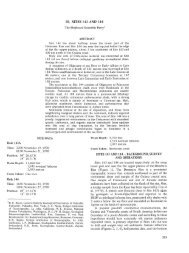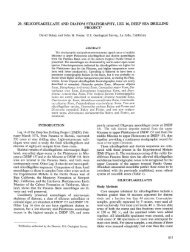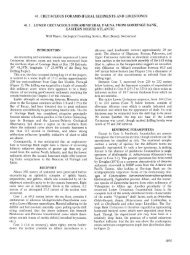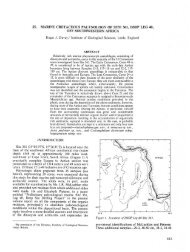19. Campanian Larger Foraminifera from Site 98, Leg XI of the Deep ...
19. Campanian Larger Foraminifera from Site 98, Leg XI of the Deep ...
19. Campanian Larger Foraminifera from Site 98, Leg XI of the Deep ...
You also want an ePaper? Increase the reach of your titles
YUMPU automatically turns print PDFs into web optimized ePapers that Google loves.
<strong>19.</strong> CAMPANIAN LARGER FORAMINIFERA FROM SITE <strong>98</strong>,<br />
LEG 11 OF THE DEEP SEA DRILLING PROJECT<br />
(NORTHWEST PROVIDENCE CHANNEL, BAHAMA ISLANDS)<br />
The following larger foraminifera were found in <strong>the</strong><br />
Upper Cretaceous 272 to 318 meter interval (Cores 13,<br />
Hand 15) <strong>of</strong> <strong>Site</strong> <strong>98</strong>:<br />
Core 13, core catcher:<br />
Vaughanina barken, Ctenorbitoides cardwelli (1 specimen),<br />
Sulcoperculina cf. globosa (1 specimen).<br />
Core 13, thin sections:<br />
Torreina torrei (frequent), Pseudorbitoides sp.,<br />
Vaughanina barken, Sulcoperculina cf. globosa,<br />
unidentified miliolid <strong>of</strong> Raadshovenia group, fragments<br />
<strong>of</strong> cuneolinids.<br />
Core 14, 58-60 cm and core catcher:<br />
Pseudorbitoides israelskyi (1 specimen), Torreina sp.<br />
(fragments), Vaughanina barkeri, Aktinorbitoides sp.<br />
(2 specimens), Sulcoperculina dickersoni, S. cf. globosa,<br />
Coskinolina sp. (1 specimen).<br />
Center bit sample between Cores 14 and 15:<br />
Orbitoides tissoti, Lepidorbitoides cf. minor, Torreina<br />
torrei, Pseudorbitoides israelskyi, Vaughanina cubensis,<br />
Smoutina bermudezi (1 oblique section), 1 specimen <strong>of</strong><br />
an unidentified larger rotalid s.l., fragments <strong>of</strong> rudist<br />
shells, fish otoliths (2 specimens).<br />
Core 15-1, thin section:<br />
Coskinolina sp.<br />
Preservation <strong>of</strong> <strong>the</strong> foraminiferal fauna is usually ra<strong>the</strong>r<br />
bad; The internal walls are coated with a thick layer <strong>of</strong><br />
calcite crystals (see scanning electron microscope pictures<br />
on Plate 2). The material is <strong>the</strong>refore not well<br />
suited to elucidate questions <strong>of</strong> structural morphology.<br />
The fauna as a whole corresponds very much to <strong>the</strong><br />
Cuban Upper Cretaceous assemblages <strong>from</strong> <strong>the</strong> Habana<br />
group, Via Blanca formation (Palmer, 1934; Brönnimann<br />
and Rigassi, 1963), and to <strong>the</strong> assemblage<br />
collected by <strong>the</strong> Glomar Challenger on <strong>Leg</strong> 1, <strong>Site</strong> 4A<br />
(Sachs, 1969). The fauna <strong>of</strong> <strong>Leg</strong> 11, <strong>Site</strong> <strong>98</strong> differs<br />
<strong>from</strong> <strong>the</strong>se by <strong>the</strong> predominance <strong>of</strong> orbitoids and in<br />
particular <strong>of</strong> Torreina torrei in <strong>the</strong> center bit sample<br />
between Cores 14 and 15.<br />
L. Hottinger, Geological and Paleontological Institute,<br />
University <strong>of</strong> Basel, Basel (Switzerland)<br />
The known stratigraphic distribution <strong>of</strong> <strong>the</strong> species<br />
mentioned here ties in quite well with <strong>the</strong> associated<br />
planktonic assemblages in <strong>the</strong> Cuban material (Brönnimann<br />
and Rigassi, 1963), and in <strong>Site</strong> 4A <strong>of</strong> <strong>Leg</strong> 1. In<br />
addition, Orbitoides tissoti can be correlated directly<br />
with <strong>the</strong> European type section <strong>of</strong> <strong>the</strong> <strong>Campanian</strong><br />
stage.<br />
REMARKS ON THE FIGURED FORAMINIFERA<br />
<strong>Larger</strong> foraminifera <strong>from</strong> <strong>the</strong> <strong>Campanian</strong> level at <strong>Site</strong><br />
<strong>98</strong> figured in Plates 1, 2 and 3 are briefly commented<br />
on below. The incomplete synonymy lists, preceding<br />
each comment, hint at <strong>the</strong> most important literature<br />
for identifying <strong>the</strong>se species.<br />
Orbitoides tissoti Schlumberger, 1902<br />
(Plate 1, Figures 2 and 3; Text-figures 1-7.)<br />
1902 Orbitoides tissoti Schlumberger. B. Soc. géol.<br />
France (Paris). 4,2, p. 259, pi. 8, fig. 21-25.<br />
1930 Orbitoides palmeri Gravell J. Paleont. (Tulsa).<br />
4,3, p. 269, pi. 22, fig. 1-10.<br />
1954 Orbitoides tissoti Schlumberger. Küpper K.<br />
Contr. Cushm. Found. Foram. Res. V. 2, p. 66,<br />
pi. 12, fig. 1,2; text fig. 2 12-15.<br />
1966 Orbitoides tissoti (?) Schlumberger. Van Hinte,<br />
J. E. K. Nederl Akad. Wetensch. (Amsterdam).<br />
B. 69,1, p. 100, pi. I, FR 821.<br />
Small, thickly-lenticular species with a threechambered<br />
megalospheric embryo; largest diameter <strong>of</strong><br />
embryo: 0.25-0.4 millimeter. Four auxiliary chambers;<br />
one microspheric specimen with at least 6 biserial early<br />
chambers (Text-Figure 1).<br />
Remarks:<br />
O. tissoti is <strong>the</strong> only larger foraminifer providing direct<br />
correlation with <strong>the</strong> type <strong>Campanian</strong>. The preservation<br />
and <strong>the</strong> number <strong>of</strong> available specimens does not allow<br />
<strong>the</strong> quantitative methods <strong>of</strong> determination suggested<br />
by Van Hinte (1966) to be used, but determination on<br />
a typological basis seems to be secure enough to<br />
correlate <strong>the</strong> orbitoids <strong>of</strong> <strong>the</strong> tissoti group with <strong>the</strong><br />
lowest morphological unit found by Van Hinte (1966)<br />
in <strong>the</strong> type section <strong>of</strong> <strong>the</strong> <strong>Campanian</strong> stage in <strong>the</strong> 526<br />
to 821 meter interval.<br />
595
10<br />
0,5 mm<br />
Figures 1-11. Orbitoidal embryos in equatorial sections, <strong>from</strong> station <strong>98</strong>, center bit sample between Bl 14 and 15.<br />
Figure 1. Orbitoides tissoti Schlumberger, microspheric form.<br />
Figures 2-7. Orbitoides tissoti Schlumberger, megalospheric forms. Auxiliary chambers dotted.<br />
Figures 8,9. Torreina torrei Palmer.<br />
Figures 10, 11. Lepidorbitoides cf. minor Schlumberger.<br />
According to Van Hinte (1965 and 1967), O. tissoti<br />
occurs <strong>the</strong>re toge<strong>the</strong>r with a planktonic assemblage<br />
comprising Globotruncana area, G. cretacea, G. fornicata,<br />
G. linneiana, and G. marginata. The benthonic<br />
smaller foraminifer Bolivinoides decoratus and B.<br />
miliaris also occur.<br />
Lepidorbitoides cf. minor<br />
(Schlumberger), 1902<br />
(Plate 1, Figure 1; Text-Figures 10 and 11)<br />
Two specimens which differ <strong>from</strong> L. minor by <strong>the</strong><br />
more isolepidine shape <strong>of</strong> <strong>the</strong> embryo and by <strong>the</strong>ir<br />
longer, and more asymmetric initial spirals were found.<br />
They differ <strong>from</strong> L. palmerae Thiadens, 1937, by<br />
having much thicker embryonic walls and much smaller<br />
chambers in <strong>the</strong> main layer. L. macgillavryi Thiadens,<br />
1937, has an embryo about half <strong>the</strong> size <strong>of</strong> that <strong>of</strong> L.<br />
596<br />
cf. minor. Preservation and scarceness <strong>of</strong> specimens do<br />
not allow a detailed comparison with L. minor <strong>of</strong> <strong>the</strong><br />
European type Maestrichtian. All Lepidorbitoides species<br />
need revision before <strong>the</strong>y can be used for detailed<br />
biostratigraphic correlation.<br />
Torreina torrei Palmer, 1934<br />
(Plate 1, Figures 6-8, Text-Figures 8 and 9)<br />
1934 Torreina torrei Palmer. Soc. Cubana Hist. Nat.<br />
(Havana). 8, p. 237, pi. 12, fig. 1,4.<br />
1962 Torreina torrei Palmer. Hanzawa S., Micropaleontology.<br />
(New York) 8, 2, p. 133, pi. 1,<br />
fig. 45, 53-55.<br />
Spherical, gypsina-like foraminifera with an orbitoidal<br />
embryo. Largest diameter 0.55 millimeter. Auxiliary
chambers not restricted to equatorial plane. No equatorial<br />
layer <strong>of</strong> main chambers. The system <strong>of</strong> intercameral<br />
communication in <strong>the</strong> radially arranged<br />
chambers, and <strong>the</strong> arrangement <strong>of</strong> auxiliary chambers<br />
around <strong>the</strong> spherical embryo are not yet understood.<br />
Pseudorbitoids<br />
Pseudorbitoids seem to be closely related to Sulcoperculina,<br />
a rotalid which develops marginal exits <strong>from</strong> <strong>the</strong><br />
intraseptal canal system. They differ <strong>from</strong> European<br />
Cretaceous orbitoidal rotalids {Orbitokathina etc.;<br />
Hottinger, 1966) by <strong>the</strong>ir imperforate periphery which<br />
admits to <strong>the</strong> large apertures <strong>of</strong> <strong>the</strong> canal system, and<br />
by <strong>the</strong>ir tendency toward planispiral involute growth.<br />
The generic and specific definitions rn.Pseudorbitoid.es,<br />
Vaughanina and related genera will have to be revised<br />
when sufficiently well-preserved material is available.<br />
Pseudorbitoides israehkyi Vaughan and Cole, 1932<br />
(Plate 1, Figures 4 and 5; Plate 3, Figure 6)<br />
1943 P. israelskyi Vaughan and Cole. Vaughan T. W.<br />
and Cole W. S., J. Paleont. (Menasha, Wise.)<br />
77,1, p. <strong>98</strong>; pi. 17, fig. 1,2.<br />
Spiral embryo composed <strong>of</strong> 8 to 9 chambers. Diameter<br />
<strong>of</strong> proloculus 0.1 millimeter (Plate 3, Figure 3).<br />
Megalospheric P. trechmanni Douvillé (Brönnimann<br />
1955) has two prime auxiliary chambers.<br />
The European P. longispiralis Papp and Küpper (1953)<br />
occurs at a similar stratigraphic level associated with O.<br />
tissoti but shows a much longer embryonic spiral (16<br />
to 20 spiral chambers). The generic assignment is<br />
doubtful, as structural details cannot be recognized in<br />
<strong>the</strong> single published picture. Material <strong>from</strong> Switzerland,<br />
also ra<strong>the</strong>r poor (Hottinger, 1967), does not show<br />
radial structures in <strong>the</strong> equatorial main layer.<br />
Vaughanina cubensis Palmer, 1934<br />
(Plate 1, Figure 9; Plate 3, Figure 5)<br />
1943 V. cubensis Palmer. Vaughan T. W. and Cole W.<br />
S., J. Paleont. (Menasha, Wise.) 77,1, p. <strong>98</strong>; pi.<br />
17, fig. 3,4; pi. 18, fig. 1-10.<br />
1954 V. cubensis Palmer. Brönnimann. Contr.<br />
Cushm. Found. Foram. Res. 5,3, p. 91, pi. 16,.<br />
fig. 1-11; pi. 17, fig. 1-6; pi. 18, fig. 4-10; text<br />
fig. 1-9.<br />
Spiral embryo composed <strong>of</strong> 13 rotaloid chambers.<br />
Diameter <strong>of</strong> proloculus 0.08 - 0.01 millimeter. The first<br />
lateral chambers connect directly with <strong>the</strong> intraseptal<br />
canal system.<br />
Vaughanina barken Brönnimann, 1954<br />
(Plate 1, Figures 10 and 11; Plate 2, Figures 3 and 4;<br />
Plate 3, Figures 1 and 2)<br />
1954 V. barkeri Brönnimann. Contr. Cushm. Found.<br />
Foram. Res. 5,3, p. 103; pi. 18, fig. 1-3; text<br />
fig. 10.<br />
Tightly coiled, juvenile stage composed <strong>of</strong> about 30<br />
chambers. Diameter <strong>of</strong> megalosphere 0.03 millimeter.<br />
The particular canal system pointed out by Brönnimann,<br />
1954 has not been observed in our ra<strong>the</strong>r badly<br />
preserved material. Scanning microscope pictures show<br />
<strong>the</strong> minute perforation in <strong>the</strong> vertical walls separating<br />
lateral chambers (Plate 2, Figure 4).<br />
Aktinorbitoides sp.<br />
(Plate 2, Figure 2)<br />
1958 A. browni Brönnimann. Micropaleontology.<br />
4,2, 167, pi. 1, fig. 1-9; pi. 2, fig. 1-10; text<br />
fig. 2-6.<br />
Two badly preserved specimens generically recognizable<br />
by <strong>the</strong>ir spines. The specimens have not been cut<br />
and, <strong>the</strong>refore, can not be determined specifically.<br />
Ctenorbitoides cardwelli Brönnimann, 1958<br />
(Plate 2, Figure 1; Plate 3, Figure 3)<br />
1958 C. cardwelli Brönnimann. Micropaleontology.<br />
4,2, 171, pi. 3, fig. 1-6; plate 4, fig. 1-7; pi. 5,<br />
fig. 1-4, 6-8, 10-13; plate 7, fig. 1-4; text<br />
fig. 7-9.<br />
One ra<strong>the</strong>r nicely preserved specimen which was<br />
photographed in <strong>the</strong> scanning microscope first (Plate 2,<br />
Figure 1) and cut in an axial direction afterwards (Plate<br />
3, Figure 3).<br />
Sulcoperculina d.globosa de Cizancourt, 1949<br />
Plate 2, Figures 6 and 7;Plate 3, Figure 4<br />
1967 Sulcoperculina globosa de Cizancourt. Butterlin<br />
J., Rev. Micropal. (Paris). 70,1, pi. 61; pi. 1,<br />
fig. 11<br />
This sulcoperculinid is probably a new clearly trochospiral<br />
species <strong>of</strong> <strong>the</strong> S. globosa - obesa group which are<br />
defined by <strong>the</strong>ir thickened shells with very little or no<br />
external ornamentation. There are not only marginal<br />
but also a few umbilical openings <strong>of</strong> <strong>the</strong> intraseptal<br />
canal system suggesting a rotaloid origin <strong>of</strong> Sulcoperculina.<br />
The same trochoid species occurs in strata <strong>of</strong><br />
<strong>Campanian</strong> age associated with <strong>the</strong> hippuritids Barret<br />
tia and Torreites and with Pseudorbitoides trechmanni<br />
in Jamaica (Jung, 1970; see also Butterlin,<br />
1956) and in Haiti (Butterlin, 1967). This form might<br />
represent an ancestor <strong>of</strong> <strong>the</strong> more or less planispiral<br />
Maestrichtian S. globosa and will be described elsewhere<br />
in detail.<br />
597
Sulcoperculina dickersoni (Palmer), 1934<br />
(Plate 2, Figure 5)<br />
1934 ICamerina dickersoni Palmer. Mem. Soc. Cuban<br />
Hist. Nat. 8,4; p. 243; pl. 14, fig. 1, 2, 4, 6, 8;<br />
text fig. 4, 5.<br />
Few specimens showing <strong>the</strong> badly preserved ornamentation<br />
on <strong>the</strong> lateral surface <strong>of</strong> <strong>the</strong> shell and <strong>the</strong> typical<br />
shape and number <strong>of</strong> main chambers.<br />
References<br />
Bronnimann, P., 1955. Upper Cretaceous orbitoidal<br />
foraminifera <strong>from</strong> Cuba. III. Pseudorbitoides<br />
Douvillé, 1922: Contr. Cushm. Found. Foram. Res.<br />
VI(2), 57.<br />
Bronnimann, P. and Rigassi, D., 1963. Contribution to<br />
<strong>the</strong> geology and paleontology <strong>of</strong> <strong>the</strong> area <strong>of</strong> <strong>the</strong> City<br />
<strong>of</strong> La Habana, Cuba, and its surroundings. Eclog.<br />
Geol. Helv. 56(1), 193.<br />
Butterlin, J., 1956. Une Micr<strong>of</strong>aune nouvelle du<br />
Crétacé superieur de la République d'Haiti. Bull.<br />
Soc. Geol. France. 6(6), 163.<br />
, 1967. Au sujet de la presence en Europe du<br />
genre Sulcoperculina Thalmann, 1939. Rev. Micropaleont.<br />
(Paris). 10(1), 61, pl. 1.<br />
Hottinger, L. 1966. Foraminiferes rotaliformes et<br />
Orbitoides du Sénonien inferieur pyrénéen. Eclog.<br />
Geol. Helv. 59(1), 277.<br />
5<strong>98</strong><br />
, 1967, 9. Europàisches Mikropalàontologisches<br />
Kolloquim (1965). Diskussionsbeitràge und<br />
Ergànzangen zum Exkursionsführer. 3b. Zur Grossforaminiferenfauna<br />
des Niesenflyschs am Niesengipfel.<br />
Bull. Ver. Schweiz. Petrol. Geol. u. Ing.<br />
33(84), 70.<br />
Jung, P., 1970. Torreites sanchezi (Douvillé) <strong>from</strong><br />
Jamaica. Palaeontogr. Americana. VII(42), 5.<br />
Palmer, B. K., 1934. Some large fossil foraminifera<br />
<strong>from</strong> Cuba. Mem. Soc. Cubana Hist. Nat. 8(4), 235.<br />
Papp, A. and Küpper, K., 1953. Die Foraminiferen von<br />
Guttaring und Klein St. Paul (Kàrnten). III. Foraminiferen<br />
aus dem Campan von Silberegg. Sitzungsber.<br />
òesterr. Akad. Wiss. Ma<strong>the</strong>m.-Natw. Kl. (I). 162(5),<br />
345.<br />
Sachs Jr., K. N., 1969. Report on larger foraminifera<br />
<strong>from</strong> <strong>Site</strong>s 4 and 5. In M. Ewing et al., 1969. Initial<br />
Reports <strong>of</strong> <strong>the</strong> <strong>Deep</strong> Sea Drilling Project, Volume I.<br />
Washington (U.S. Government Printing Office), 3<strong>98</strong>.<br />
Van Hinte, J. E., 1965. The Type <strong>Campanian</strong> and its<br />
planktonic foraminifera. Koninkl. Ned. Akad.<br />
Wetenschap. (Amsterdam . Proc, B. 68(1), 8.<br />
, 1966. Orbitoides <strong>from</strong> <strong>the</strong> <strong>Campanian</strong> type<br />
section. Koninkl. Ned. Akad. Wetenschap. (Amsterdam).<br />
Proc, B. 69(1), 79.<br />
„, 1967. Bolivinoides <strong>from</strong> <strong>the</strong> <strong>Campanian</strong><br />
type section. 70(3), 254. Koninkl Ned. Akad.<br />
Wetenschap. (Amsterdam). Proc, B.
600<br />
PLATE 1<br />
<strong>Campanian</strong> <strong>Larger</strong> <strong>Foraminifera</strong> <strong>from</strong> <strong>Site</strong> <strong>98</strong><br />
Figure 1 Lepidorbitoides cf. minor Schlumberger, equatorial<br />
section, X 20<br />
Figure 2 Orbitoides tissoti Schlumberger, axial section <strong>of</strong><br />
particularly thick, conical specimen, X20.<br />
Figure 3 Orbitoides tissoti Schlumberger, equatorial section,<br />
X20.<br />
Figures 4, 5 Pseudorbitoides israelskyi Vaughan and Cole, slightly<br />
oblique equatorial sections, X20.<br />
Figures 6-8 Toπeina torrei Palmer, centered sections. Figure 7<br />
shows a twinned specimen; Figure 8 shows a not<br />
quite centered section. X20.<br />
Figure 9 Vaughanina cubensis Palmer, equatorial section, X20.<br />
Figure 10 Vaughanina barkeri Bronnimann, axial section, X50.<br />
Figure 11 Vaughanina barkeri Bronnimann, euqatorial section,<br />
X50.<br />
Figures 1-9 From <strong>Site</strong> <strong>98</strong>, center bit sample between Cores 14<br />
and 15.<br />
Figures 10-11 From <strong>Site</strong> <strong>98</strong>, Core 14.
PLATE 1<br />
601
602<br />
PLATE 2<br />
Scanning Electron Micrographs <strong>of</strong> Pseudorbitoids<br />
and Sulcoperculina showing <strong>the</strong> State <strong>of</strong> Preservation<br />
Figure 1 Ctenorbitoides cardwelli Brönnimann, external view,<br />
X50. From <strong>Site</strong> <strong>98</strong>, Core 13.<br />
Figure 2 Aktinorbitoides sp., external view showing spines,<br />
X45. From <strong>Site</strong> <strong>98</strong>, Core 14.<br />
Figure 3 Vaughanina barken Brönnimann, external view, X50.<br />
From <strong>Site</strong> <strong>98</strong>, Core 14.<br />
Figure 4 Vaughanina barken Brönnimann, lateral chamber<br />
broken up, showing perforation <strong>of</strong> chamber floor and<br />
chamber walls. X450. From <strong>Site</strong> <strong>98</strong>, Core 14.<br />
Figure 5 Sulcoperculina dickersoni (Palmer), lateral view showing<br />
ornamentation, X50. From <strong>Site</strong> <strong>98</strong>, Core 14.<br />
Figure 6 Sulcoperculina cf. globosa de Cizancourt, erodet<br />
specimen, X 100, <strong>from</strong> <strong>Site</strong> <strong>98</strong>, Core 14.<br />
Figure 7 Sulcoperculina cf. globosa de Cizancourt, detail,<br />
X200. From <strong>Site</strong> <strong>98</strong>, Core 14. C: chamber cavity.<br />
L: ventral, lateral wall with coarse perforations.<br />
M: marginal apertures <strong>of</strong> intraseptal canal system.<br />
S: septum.
PLATE 2<br />
603
604<br />
PLATE 3<br />
Neanic and First Adult Stages <strong>of</strong> Pseudorbitoids<br />
Compared to Sulcoperculina, all X34, <strong>from</strong><br />
<strong>Leg</strong> 11, <strong>Site</strong> <strong>98</strong>.<br />
Figure 1 Vaughanina barken Brönnimann, equatorial section.<br />
From Core 14.<br />
Figure 2 Vaughanina barken Brönnimann, axial section, not<br />
quite centered. From Core 14.<br />
Figure 3 Ctenorbitoides cardwelli Brönnimann, axial section.<br />
From Core 13.<br />
Figure 4 Sulcoperculina cf. globosa de Cizancourt, axial section,<br />
entire specimen, From Core 14.<br />
Figure 5 Vaughanina cubensis Palmer, equatorial section.<br />
From Core 14.<br />
Figure 6 Pseudorbitoides israelskyi Vaughan and Cole, equatorial<br />
section. From center bit sample between Cores<br />
14 and 15.
PLATE 3<br />
605



